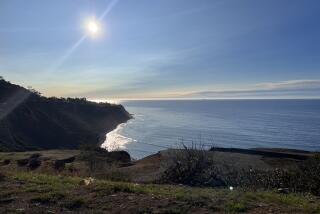Search Continues for Marines Whose Copter Crashed
- Share via
An intense sea search was underway Sunday for the four El Toro Marines who were aboard an assault helicopter that went down during a training exercise the night before about six miles offshore, officials said.
The CH-46 Sea Knight helicopter crashed at 9:26 p.m. Saturday, shortly after taking off from the Juneau, a Navy amphibious transport and assault ship based in San Diego, according to Navy Lt. Megan Mason.
The Marines, Navy and Coast Guard teamed up to search Saturday night and Sunday for any survivors in the deep waters off Oceanside, Mason said. Some debris and a portion of the fuselage were found, but there was no trace of the flight crew, officials said.
“We’ll keep looking. We don’t leave our Marines,” Mason said. “You have to keep going through the process of searching, and evaluating how the search is going. Eventually you have to make a decision about continuing, but for now we’re in the searching mode.”
The Sea Knight is a 45-foot, double-engine helicopter first used in the Vietnam War. For years, the helicopter has been a versatile assault, transport and search craft. But now, the helicopters are among the oldest aircraft used by the U.S. military.
Military officials have conceded that a substitute is needed for the 238 Sea Knights still in use by the Marines, and a plan is in place to replace the 31-year-old model with the V-22 Osprey by 2001.
The crash happened one year to the day after 14 Marines were killed when a Sea Knight helicopter collided with an AH-1 Cobra assault craft during training in North Carolina.
The cause of Saturday’s crash remains under investigation, according to Marine Gunnery Sgt. Lee Tibbets, a Camp Pendleton spokesman. He said the names of crew members would be withheld until their families were contacted.
Mason said she did not know if the pilots were flying with the assistance of night goggles. The light-amplifying goggles can distort vision and have been investigated as a possible contributing factor to dozens of accidents since the 1970s.
More information about the crash will become apparent as the investigation proceeds, Mason said, “but right now our priority is to get our people back.”
The four-member crew was part of a helicopter squadron from the Marines’ El Toro base serving a six-month stint with the 13th Marine Expeditionary Unit at Camp Pendleton, according to Sgt. Chris O’Leary, a spokesman at El Toro.
The crew was involved in routine exercises to prepare them for a six-month deployment, Mason said, adding that the exact nature of the exercise was unclear Sunday.
The Juneau was the lead ship in the search for the missing 24,300-pound helicopter. It was joined by helicopters, teams of divers, three Navy ships and a group of Coast Guard patrol boats, Mason said.
Safety upgrades and other augmentations have been underway in recent years to keep the Sea Knight helicopters in service, while restrictions have lowered its speed and passenger limits. Much of its equipment is obsolete, and many of its spare parts are no longer made.
Other recent incidents involving the CH-46 include:
* A Marine Corps helicopter that had carried reporters accompanying President Clinton’s campaign rolled over and burned at an Orlando, Fla., airport on Sept. 6, 1996.
* The same day, a second Marine CH-46 accompanying the president made a “precautionary” landing south of Orlando after a warning light lit up, possibly indicating hydraulic system problems.
* A Camp Pendleton corporal was killed and three other Marines were injured on Aug. 19, 1996, after their CH-46 caught fire in midair and was forced to make an emergency landing about 25 miles from Kuwait City.
* In 1989, 14 Marines were killed when their CH-46 crashed as it took off from a ship in the seas south of Okinawa. The helicopter was taking part in a night training operation. Four days earlier, two El Toro Marines were killed when their CH-46 crashed in the Nevada desert.
More to Read
Sign up for Essential California
The most important California stories and recommendations in your inbox every morning.
You may occasionally receive promotional content from the Los Angeles Times.










